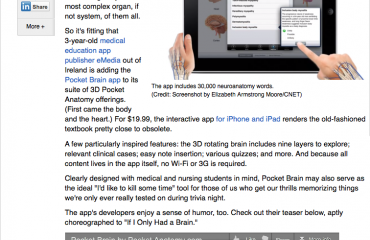Full Text:
Appy Hearts: Galway company’s iPhone app generates sales and PR in international markets.
Galway company eMedia has developed the Pocket Heart – an iPhone application, enabling users to drill down and see the visuals and workings of the human heart. The device has been piloted with 16 to 18 years olds – in transition, fifth and sixth year. It is also aimed at pre-med students entering medicine in the US, some of whom are coming from a humanities rather than a science background.
eMedia’s third receptive audience are cardiology diagnosis patients whose consultants want to explain what’s happening to them. Currently, this is done using wall-charts, but there is keen interest in using a digital tool to explain procedures to patients in the under-sixties age category.
Finally, eMedia’s Mark Campbell says the Pocket Heart has found fans as a gadget among the general public. So far, it has featured on about eight review sites and sold in 18 countries. (See www.pocketanatomy.com)
“The pocket heart is a massive shift in what we do,” he says, adding that it is part of a move to transition the business from a small to a mid-sized company
“We now have sales in 18 countries, which has made us aware of markets outside Ireland. A year ago, we wouldn’t have believed we would be here.”
While the application hasn’t made the company a mint, sales have covered development costs, and the application has generated enormous PR. As an example, when we spoke, Campbell was heading to a meeting with cardiologist members of Croi, a charity to which it is donating a percentage of profits from the Pocket Heart. “It is creating nice synergies and profile,” he says.
The company is now looking to expand with a suite of iPhone applications, as well as online versions for people who don’t have an iPhone. Ultimately, the aim is to create a ‘Google Earth maps’-type searchable and navigable map of the human body, allowing users to select a location and drill down past skin, bones and muscle, layer by layer. The project is vast and complex, Campbell concedes. But as a company already providing 3-D medical animation to healthcare, medical technology companies and universities, eMedia is well positioned.
A second arm of development would include building quizzes into the application and creating an e-learning tool. In the meantime, the company is planning to develop a 2-D version of the human body. This will have a reasonable amount of content and be applicable to secondary schools and first year university students.
Source: The Market Magazine


